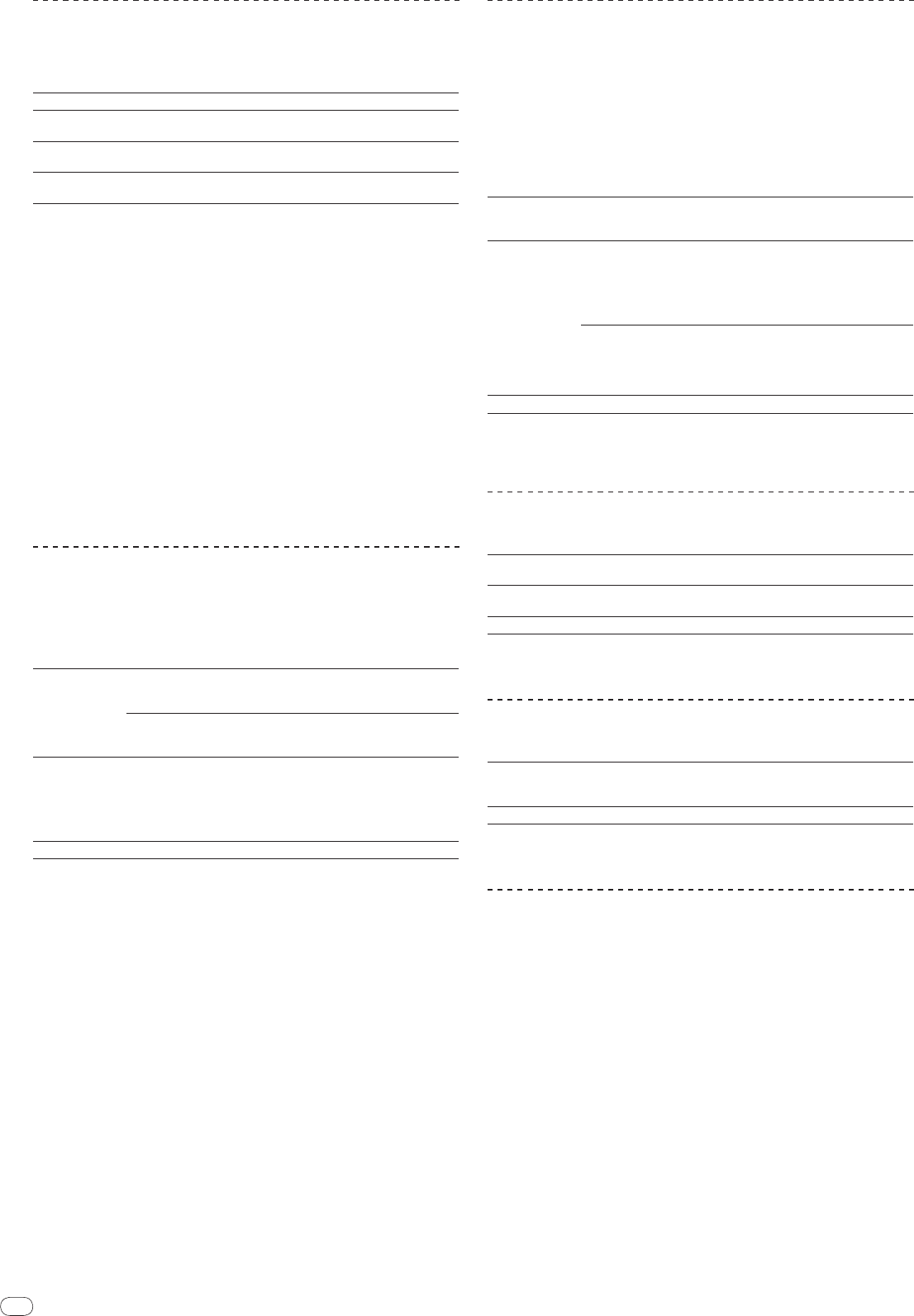
En
8
About USB devices
Music files (MP3/
AAC/
WAV/
AIFF) recorded on USB devices can be played.
Such data as disc identification information, cue points, loop points and hot cues
can be recorded on USB devices.
Folder layers Max. 8 levels (files in folders beyond the 8th level cannot be played)
Max. number of
folders
Unlimited (folders beyond the 10 000th folder within a single folder
cannot be displayed)
Max. number of
files
Unlimited (files beyond the 10 000th file within a single folder cannot
be displayed)
Supported file
systems
FAT, FAT32 and HFS+
! The CDJ-2000 supports such USB mass storage class USB devices as external hard
discs, portable flash memory drives and digital audio players. External DVD/
CD drives
and other optical disc devices cannot be used.
! When there are many folders or files, some time may be required for loading.
! If multiple partitions are set for the USB device, the device may not be recognized.
Cautions on using USB devices
! Some USB devices may not operate properly. Please note that Pioneer will
accept no responsibility whatsoever for loss of data recorded on USB devices.
! USB hubs cannot be used.
! USB devices equipped with flash card readers may not operate.
! If a current above the allowable level is detected in the CDJ-2000’s USB port,
it could happen that a warning message is displayed, the power to the USB
device is cut off and signal transfer is stopped. To restore normal operation,
remove USB devices connected to the player, then press USB STOP. Avoid
reusing the USB device for which the excess current was detected. If normal
operation is not restored after performing the above operation (if signals are
not transferred), try turning off the player’s power then turning it back on.
! Depending on the USB device you are using, the desired performance may
not be achieved.
About MP3 files
MP3 files can have a constant bit rate (CBR) or a variable bit rate (VBR). Both
types of files can be played on the CDJ-2000, but the search and super fast search
functions are slower with VBR files. If your priority is operability, we recommend
recording MP3 files in CBR.
The CDJ-2000 supports MP3 files in the formats shown below.
Compatible
formats
MPEG-1
Audio Layer-3 sampling frequencies of 32 kHz, 44.1
kHz and 48 kHz, and bit rates of 32 kbps – 320 kbps
are supported.
MPEG-2
Audio Layer-3 sampling frequencies of 16 kHz,
22.05 kHz and 24 kHz, and bit rates of 16 kbps – 160
kbps are supported.
Track information
ID3 tag versions 1.0, 1.1, 2.2, 2.3 and 2.4 are sup-
ported.
Titles, album names, artist names, etc., are dis-
played here.
1
JPEG images embedded in ID3 tags are displayed
as the jacket photo.
2
File extension .mp3
1 To display characters written in a local code other than Unicode, change the [LAN-
GUAGE] setting at [UTILITY] (page 22).
2 Files larger than 800 x 800 dots cannot be displayed.
About AAC files
! AAC is the abbreviation of “Advanced Audio Coding”, a basic format of audio
compression technology used for MPEG-2 and MPEG-4.
! The file format and extension of AAC data depends on the application used to
create the data.
! In addition to AAC files encoded with iTunes
®
and with the extension “.m4a”,
files with the extensions “.aac” and “.mp4” can also be played on the CDJ-
2000. However, copyright protected AAC files purchased for example at the
iTunes Music Store cannot be played. Also, some files may not be playable,
depending on the iTunes version used to encode them.
! The CDJ-2000 supports AAC files in the formats shown below.
Compatible
formats
MPEG-4 AAC LC
Sampling frequencies of 16 kHz, 22.05 kHz, 24 kHz,
32 kHz, 44.1 kHz and 48 kHz, and bit rates of 16
kpbs – 320 kbps are supported.
Track information
aac
ID3 tag versions 1.0, 1.1, 2.2, 2.3 and 2.4 are sup-
ported.
Titles, album names, artist names, etc., are dis-
played here.
1
JPEG images embedded in ID3 tags are displayed
as the jacket photo.
2
Extensions other
than aac
Meta tags (embedded tags) are supported.
Titles, album names, artist names, etc., are dis-
played here.
1
JPEG images embedded in tags are displayed as
the jacket photo.
2
File extension .m4a, .aac and .mp4
1 To display characters written in a local code other than Unicode, change the [LAN-
GUAGE] setting at [UTILITY] (page 22).
2 Files larger than 800 x 800 dots cannot be displayed.
About WAV files
The CDJ-2000 supports WAV files in the formats shown below.
Compatible
formats
The 16-/
24-bit non-compressed PCM format and sampling frequencies
of 44.1 kHz and 48 kHz are supported.
Track information
LST chunk
Titles, album names, artist names, etc., are displayed here.
1
File extension .wav
1 To display characters written in a local code other than Unicode, change the [LAN-
GUAGE] setting at [UTILITY] (page 22).
About AIFF files
The CDJ-2000 supports AIFF files in the formats shown below.
Compatible
formats
The 16-/
24-bit non-compressed PCM format and sampling frequencies
of 44.1 kHz and 48 kHz are supported.
Titles, album names, artist names, etc., are displayed here.
1
File extension .aif, .aiff
1 To display characters written in a local code other than Unicode, change the [LAN-
GUAGE] setting at [UTILITY] (page 22).
About rekordbox
! rekordbox is an application for managing music files which are used for DJ
play with a Pioneer DJ Player (i.e. CDJ-2000, CDJ-900).
Data that has been detected and measured, as well as any points which
have been set and stored using rekordbox, can be used in combination with
a Pioneer DJ Player (i.e. CDJ-2000, CDJ-900) to achieve outstanding DJ
performance.
! Install rekordbox from the included CD-ROM onto a computer. For instruc-
tions on using rekordbox, see Using in combination with rekordbox on page 12
and About the rekordbox software on page 23.


















